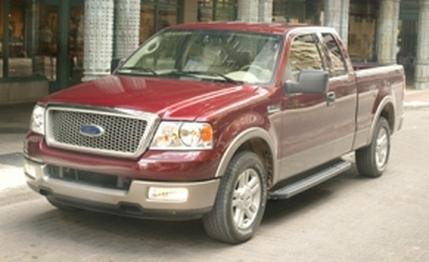
 Road Test
Road Test
Congratulate yourself on staving off mortality long enough to witness the birth of another redesigned Ford F-150. You have no doubt already noticed that burly pack-mule pickups are mellowing through modernization into a new breed. Call them big cars with a back porch. The new F-150 inches the needle even farther. Interior acreage, comfort, cabin isolation, and drivability are all up. The Lariat luxury barge has trimmings sufficient to upstage a Lincoln. How about an electrically sliding pane in the rear window? Don't let the cowhands see that, or they'll hoot you off the hacienda.
Oh, Ford's got new F-150s for plumbers and roughnecks, too. They even get a slightly different dashboard with plainer gauges and fewer glints. Frisky models such as the mudslinging FX4 move the shifter down to the chrome-accented center console and feature sporty gauges. Need four real doors à la Dodge Ram? Ford will show you to a new F-150 SuperCrew.
Company research shows the majority of F-150s serve as personal-use vehicles, with passengers and groceries two of the most frequent items on the cargo manifest. Suitably, perhaps, we were delivered the line's most deluxe model, the Lariat, fitted with a two-plus-two-door SuperCab and its most sedate suspension and rear-wheel drive. Under the hood: the biggest-bore engine, the new 5.4-liter 24-valve V-8 with variable valve timing on its single overhead cams. We filled it with people and groceries and lots of gas and drove it accordingly.
The F-150's looks mirror the Explorer's, and the pickup drew some initial yawns. We plunged our Lariat into an antique-show crowd to retrieve a turn-of-the-century oak dresser, and only two people stopped to study it. This in a region where many families eat and pay mortgages on F-150 sales. But then, Ford sold 813,701 F-series trucks in 2002, far too many chips to gamble on a heat-of-the-moment design. The F-150 shape is conservative, it's clean, and it's a no-brainer.
Right away we noticed the truck's new whirligigs. Our Lariat had the pickup segment's first power windows on the SuperCab's two rear-hinged minidoors. The steel tailgate incorporates small torsion bars that nicely lighten the effort of slamming it (although now you need tools to remove it), and the overhead console slides on tracks that accept different modules. Cell-phone holders and flat-screen TVs will fit, plus anything the industrious aftermarket can cook up. We'd opt for a towel wringer and a pickle dispenser.
We've become accustomed to scaling the side of our towering long-term Dodge Ram 1500 Quad Cab (June 2003), so sliding into the Lariat's leather chairs is low-altitude work, thanks to the $250 full-length running boards and a relatively modest ride height. The Lariat's cabin takes a stab at modern design, as if someone had stapled a Bang & Olufsen catalog to the dashboard. The center stack and the chrome-ring air vents have a textured slate finish. The cream-colored chrome-ring gauges live under an upholstered cowl dotted with French stitching. The buttons and the gear selector feel as if a watchmaker had looked in and done what he could. Only the faux wood looks cheap as it waterfalls down the center console.
The dash is clean, too clean perhaps. As it is, you get a pull-out cup-holder tray —two of eight (!) cup holders crammed into the Lariat—a small cubby underneath that is maxed out by a slim cell phone, and a shallow rubber bin up top. The center armrest does pack more debris, but people who use their dashboards as work desks will pretty quickly outclutter the available crannies.
Our Lariat's leather bench seats were stiff and slippery, but with manual lumbar adjusters, they proved comfortable during state-line leaps. All riders get a little more precious real estate in the new SuperCab, but rear-seat passengers benefit the most with five more cubic feet. The rear bench still sits too low to the floor, but the seatback is at a good recline and knees can press their own paths into the soft backsides of the front seats. Flipping up the seat bottoms to create more space is as easy as pulling a spring-loaded handle, although the 70/30-split seats simply tilt up rather than articulate backward as in some trucks.